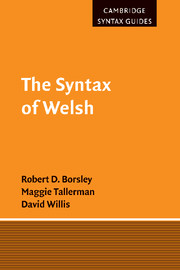7 - Syntax and mutation
Published online by Cambridge University Press: 01 October 2009
Summary
Mutation environments: some basic data
We saw in section 1.4.4 that Welsh, in common with the other Celtic languages, displays several sets of morphophonological alternations in the initial segments of words, known as consonantal mutations. In the vast majority of instances, mutation is triggered by the preceding lexical item, so that a simple list of mutation triggers is sufficient to describe the environments for the mutation. Typical triggers include prepositions, proclitics on V and N (see section 6.1), various determiners, numerals, conjunctions, complementizers and numerous other small, ‘closed class’ grammatical words. To illustrate these straightforward cases, the preposition i ‘to’ is a trigger for soft mutation, giving i Fangor ‘to Bangor’, whilst the third person feminine singular proclitic ei triggers aspirate mutation, giving ei chath (< cath) ‘her cat’. Note that mutation is assigned not to a head, but to the first word of the constituent immediately following the trigger, whatever the status of this constituent. For instance, ‘her five cats’ is ei phum cath, with aspirate mutation (pum > phum) at the start of the phrase pum cath (lit. ‘five cat’), but no mutation on the head, cath. If the first word following the mutation trigger happens not to have a mutable initial consonant, then the constituent bears no signs of the mutation: thus we get ei beic ‘her bike’, with no mutation, as /b/ cannot undergo aspirate mutation.
Information
- Type
- Chapter
- Information
- The Syntax of Welsh , pp. 223 - 254Publisher: Cambridge University PressPrint publication year: 2007
